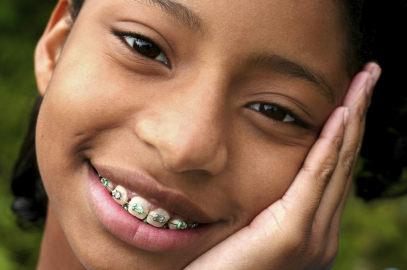Orthodontics
Q What is orthodontics?
A Orthodontics is a branch of dentistry that corrects teeth and jaws that are malpositioned. Crowded teeth and teeth that do not fit together properly are harder to keep clean, are at greater risk of being lost due to tooth decay and periodontal disease and cause extra stress on the chewing muscles that can lead to headaches, TMJ problems and neck, shoulder and back pain. Teeth that are not straight or are incorrectly placed can also detract from one's appearance.
Q What are the benefits of orthodontics?
A The benefits of orthodontic treatment include a healthier mouth, better aesthetics, and teeth that are more likely to last for a lifetime.
Q How do I Know if I Need Orthodontics?
Only your dentist or orthodontist can determine whether you can benefit from orthodontics. Based on diagnostic tools that include a full medical and dental health history, a clinical exam, plaster
models of your teeth, and special X-rays and photographs, an orthodontist or dentist can decide whether orthodontics are recommended, and develop a treatment plan that's right for you.
If you have any of the following, you may be a candidate for orthodontic treatment:
- Increased overjet, where the upper front teeth lie too far forward (stick out) over the lower teeth
- Reverse overjet — where the lower teeth are too far forward or the upper teeth too far back
- Crossbite — when the upper teeth bite inside the lower teeth
- Open bite — a space between the biting surfaces of the front and/or side teeth when the back teeth bite together
- Misplaced midline— when the center of your upper front teeth does not line up with the center of your lower front teeth
- Spacing — gaps, or spaces, between the teeth as a result of missing teeth or teeth that do not "fill up" the mouth
- Crowding — when there are too many teeth for the dental ridge to accommodate
Q How Does Orthodontic Treatment Work?
A Different types of appliances, both fixed and removable, are used to help move teeth, retrain muscles and affect the growth of the
jaws. These appliances work by placing gentle pressure on the teeth and jaws.
Fixed appliances include:
Braces — the most common fixed appliances, braces consist of bands, wires and/or brackets. Bands are fixed around the teeth or tooth and used as anchors for the appliance, while brackets are most often bonded to the front of the tooth. Arch wires are passed through the brackets and attached to the bands. Tightening the arch wire puts tension on the teeth, gradually moving them to their proper position. Braces are usually adjusted monthly to bring about the desired results, which may be achieved within a few months to a few years. Today's braces are smaller, lighter and show far less metal than in the past. They come in bright colors for children as well as clear styles preferred by many adults.
.
Removable appliances include:
Aligners — an alternative to traditional braces for adults, serial aligners are being used by an increasing number of orthodontists to move teeth in the same way that fixed appliances work, only without metal wires and brackets. Aligners are virtually invisible and are removed for eating, brushing and flossing.
Removable braces —
Used when minor corrections are required, removable braces are non-fixed braces consisting of a plastic plate with wires which allow the teeth to move gradually by applying gentle pressure.
Often used for the top jaw only, removable braces are suitable for patients of all ages. Unlike fixed braces, removable braces can be taken out of the mouth for cleaning, flossing and for sport as necessary.
In general, treatment with removable braces takes less time than fixed braces. In some cases, removable braces are used in conjunction with fixed braces.




